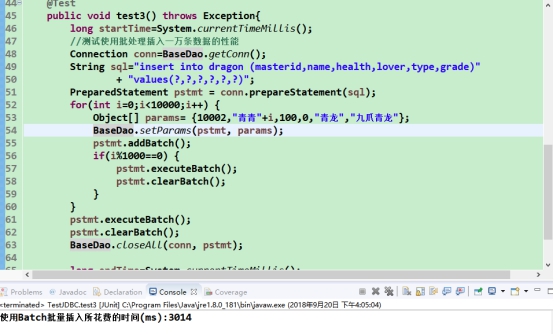一 批量插入数据(使用批处理,存储过程,和不使用批处理)的性能对比
1、 测试准备
建表,建序列,建触发器,建视图
使用的是Oracle数据库
SQL语句
--创建主人表
-- id;主人编号
-- name;主人的名字
--password;密码
--money;元宝
create table master
(
id number(5) primary key not null,
name varchar2(20),
password varchar2(20),
money number(10)
)
--创建序列
create sequence masterinsequ
increment by 1
start with 10000
nomaxvalue
nocycle
cache 10;
--插入测试数据
insert into master(id,name,password,money) values(masterinsequ.nextval,'pengjia1','123123',0);
insert into master(id,name,password,money) values(masterinsequ.nextval,'pengjia','123123',0);
--查看数据
select id,name,password,money from master
select * from master
/*
id;神兽的编号
masterId;所属的世界之主编号
name;神兽的昵称
health;健康值
lover;亲密度
type;类型
grade;// 神兽青龙所特有的
*/
?
drop table Dragon;
create table dragon(
id number(5) primary key not null,
masterid number(5) ,
constraint fk_masterid_id foreign key (masterid) references master(id),
--创建外键约束
--masterid number(5) references master(id)
name varchar2(10) ,
health number(3),
lover number(3),
type varchar2(10),
grade varchar(10)
)
select * from dragon
insert into(id,masterid,name,health,lover,type,grade) values()
--查询表
select * from dragon
--删除表
drop table dragon
select * from dragon
insert into dragon (id,masterid,name,health,lover,type,grade)
values(10002,10002,'sdfgiu',100,0,'青龙','一爪青龙')
--主键没有自动增长
--创建序列和触发器
create sequence sq_dragon_id
increment by 1
start with 1
nomaxvalue
nocycle
nocache;
create or replace trigger tr_dragon_insert
before insert on dragon for each row
begin
select sq_dragon_id.nextval into :new.id from dual;
end;
insert into dragon (masterid,name,health,lover,type,grade)
values(10002,'sdfgiu',100,0,'青龙','一爪青龙')
delete from dragon where id in(10001,10002)
--查询记录条数
select count(*) from dragon
--清空数据
truncate table dragon
--创建存储过程
create or replace procedure pro_insert_dragon
is
i number(8,0) :=0; --定义变量不需要declare
begin
loop
i:=i+1;
insert into dragon (masterid,name,health,lover,type,grade)values(10002,'青青',100,0,'青龙','九爪青龙');
exit when i>10000;
end loop;
commit;
end;
begin
pro_insert_dragon;
end;
PRO_INSERT_DRAGON
2、 测试代码
关键代码
@Test
public void test3() throws Exception{
long startTime=System.currentTimeMillis();
//测试使用批处理插入一万条数据的性能
Connection conn=BaseDao.getConn();
String sql="insert into dragon (masterid,name,health,lover,type,grade)"
+ "values(?,?,?,?,?,?)";
PreparedStatement pstmt = conn.prepareStatement(sql);
for(int i=0;i<10000;i++) {
Object[] params= {10002,"青青"+i,100,0,"青龙","九爪青龙"};
BaseDao.setParams(pstmt, params);
pstmt.addBatch();
if(i%1000==0) {
pstmt.executeBatch();
pstmt.clearBatch();
}
}
pstmt.executeBatch();
pstmt.clearBatch();
BaseDao.closeAll(conn, pstmt);
long endTime=System.currentTimeMillis();
System.out.println("使用Batch批量插入所花费的时间(ms):"+(endTime-startTime));
}

@Test
public void test4() throws Exception{
long startTime=System.currentTimeMillis();
//测试使用批处理插入一万条数据的性能
Connection conn=BaseDao.getConn();
String sql="insert into dragon (masterid,name,health,lover,type,grade)"
+ "values(?,?,?,?,?,?)";
PreparedStatement pstmt = conn.prepareStatement(sql);
for(int i=0;i<10000;i++) {
Object[] params= {10002,"青青"+i,100,0,"青龙","九爪青龙"};
BaseDao.setParams(pstmt, params);
pstmt.executeUpdate();
}
BaseDao.closeAll(conn, pstmt);
long endTime=System.currentTimeMillis();
System.out.println("不使用批量插入所花费的时间(ms):"+(endTime-startTime));
}

public void test5() throws Exception {
// 测试使用存储过程
long startTime = System.currentTimeMillis();
String sql = "call PRO_INSERT_DRAGON()";
//连接对象
Connection conn = BaseDao.getConn();
// 执行存储过程的对象
CallableStatement cStmt = conn.prepareCall(sql);
//执行存储过程
cStmt.execute();
//关闭资源
BaseDao.closeAll(conn, cStmt);
long endTime = System.currentTimeMillis();
System.out.println("使用存储过程批量插入所花费的时间(ms):" + (endTime - startTime));
}

3、 测试结果
使用Batch批量插入所花费的时间(ms)3014
使用存储过程批量插入所花费的时间(ms)3073
不使用批量插入所花费的时间(ms) 17093
使用batch和存储过程批量插入的效率在同一数量级,且比不使用批量插入的效率高很多
<wiz_tmp_tag id="wiz-table-range-border" contenteditable="false" style="display: none;">